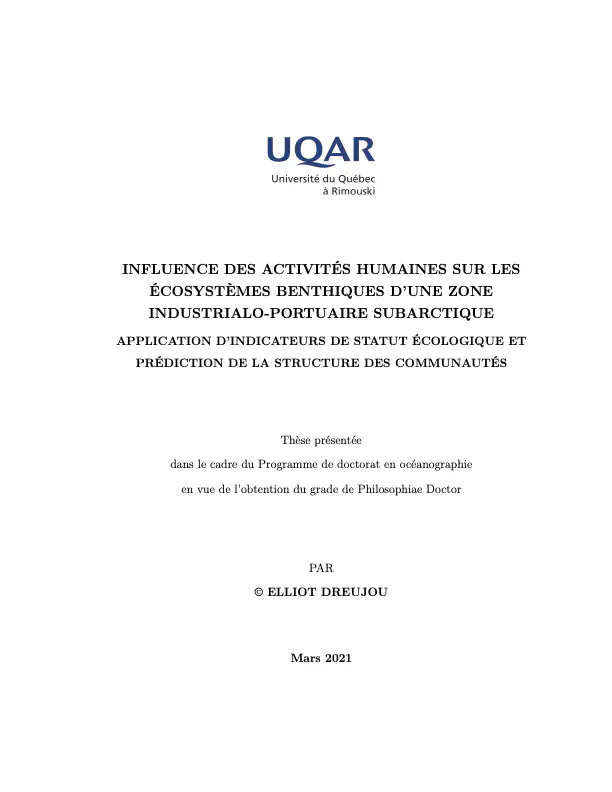Influence des activités humaines sur les écosystèmes benthiques d’une zone industrialo-portuaire subarctique – Application d’indicateurs de statut écologique et prédiction de la structure des communautés

Abstract
Coastal and ocean environments are influenced by human activities worldwide, the impacts of which can significantly modify the structure and integrity of ecosystems. In order to adequately protect the natural environment and support sustainable anthro- pogenic development, specifically in regions where multiple human activities co-occur, it is necessary to understand how marine ecosystems are influenced. Benthic communities are a particularly interesting compartment for studying these issues, because many species have a limited mobility due to their predominantly sessile lifestyle as well as a long life span. While studies assessing anthropogenic impacts have been carried out on a wide range of ecosystems around the world, few have specifically considered sub-Arctic ecosystems, where human activity is expected to increase in connection with climate change. In this context, my thesis’s main objective is to understand how the benthic ecosystems of a sub-Arctic industrial harbour area are influenced by human activities. The study area herein considered is located in the Sept-Îles region (Quebec, Canada), an important economic hub for Quebec, located in the Gulf of St. Lawrence. To address these topics, this thesis is divided into three chapters. The first chapter aimed to characterize the structure of the considered coastal ecosystems. During field campaigns and laboratory analyses, a total of 289 taxa were sampled, the majority of which, present in the Gulf of St.Lawrence, are new records in this region. Various abiotic parameters of the sediment were assessed, such as the concentration of organic matter, heavy metals and the distribution of particle size fractions. Similarity analysis of invertebrate assemblages larger than 0.5 mm showed signs of disturbance in some areas, with an increased number of pollution-tolerant and opportunistic species. Regression models highlighted which habitat variables had the most impact on the structure of communities. The second chapter looked at the ecological status of ecosystems based on the com- position of benthic communities. Sixteen indicators of ecological status were selected through a literature review, divided into three categories according to their methodology: measures of abundance, community diversity and indicator species. These indicators were applied using the species lists obtained in the previous chapter, and the majority of which identified diverse communities with no obvious sign of disturbance. In addition, several significant correlations were detected between indicators and habitat parame- ters, especially with heavy metal concentrations. Each category of indicator provided important information on the state of the ecosystem while presenting limitations, in particular about reference conditions used to define ecological status. The last chapter examined human activities influencing the ecosystem, in order to calcu- late a local anthropogenic footprint on communities according to exposure gradients. An exposure index for each activity considered (aquaculture, dredging, industrial influence, city influence, fisheries, sewage discharges, shipping) was developed using the distance from their sources and fishing events. Several links were discovered between the exposure indices obtained and the distribution of benthic invertebrates, using predictive models Hierarchical Modelling of Species Communities. The cumulative exposure index revealed areas of superposition of human activity. The profile of the communities present in these zones is not particularly disturbed, which corroborates the results of the previous chapters on the status of the ecosystems considered. This PhD thesis improves ecological knowledge in sub-Arctic coastal ecosystems, in particular by presenting the first benthic biodiversity census in the Sept-Îles region. Methods for assessing ecological status and anthropogenic exposure have been devel- oped at the local scale (< 100 km), which constitute particularly interesting tools for stakeholders in order to define management targets and support conservation initiatives.